
Exploring Rondos in Soccer: Techniques and Benefits
March 16, 2025Rondos are essential soccer drills that sharpen your technical skills, boost team dynamics, and heighten tactical awareness. These exercises involve quick passing and movement, simulating real-game pressure, and enhancing your decision-making under stress. You'll improve communication with teammates and build a competitive spirit while fostering camaraderie as you switch roles during practices. Understanding rondo variations can elevate your skill development, so there's much more to explore about how this training method can benefit your game.
What Is a Rondo?
A rondo is an engaging training drill in soccer that emphasizes possession and teamwork. In this small-sided exercise, a group of players works to maintain possession while a defending team tries to win the ball back.
Typically set up in a circular shape, the rondo encourages quick passing and close proximity, resembling the childhood game "monkey in the middle." You'll find variations, like 4v2 or 5v2, which increase pressure on the possession team, sharpening their technical and tactical skills. Passing accuracy is crucial in a rondo to ensure the team retains possession and effectively outmaneuvers the defenders. This drill also reinforces the principle of pressure and cover, as players learn to communicate and support each other while maintaining possession.
This drill is perfect for activating players both mentally and physically at the start of training sessions. Ultimately, rondos enhance fundamental abilities such as passing accuracy, ball control, and decision-making, all essential for successful gameplay. Additionally, practicing rondos helps improve teamwork and communication, which are vital skills for effective game performance.
The Origin and Evolution of the Rondo
Originating from Catalan culture, the rondo reflects a unique approach to soccer training that has evolved considerably over the years.
Initially popularized by Laureano Ruiz in 1957 at FC Barcelona, it became vital for player development. Johan Cruyff transformed the rondo from a simple warm-up into an essential tool for enhancing tactical awareness and possession play. This transformation mirrors the importance of regular practice in developing a cohesive team defense. The rondo also emphasizes the need for effective communication among players to ensure seamless transitions between offense and defense.
Today, coaches like Pep Guardiola use rondos to sharpen technical skills and foster teamwork.
Imagine the rondo as:
- A circle of players exchanging quick passes.
- Defenders closing in, testing decision-making.
- Coaches observing, guiding player movements.
- Teams celebrating improved synergy and fluidity.
This evolution makes the rondo a versatile method in modern soccer coaching. Additionally, its roots can be traced back to early forms of soccer that emphasized teamwork and skill, highlighting the foundational elements that make the rondo effective.
Key Benefits of Rondo Drills
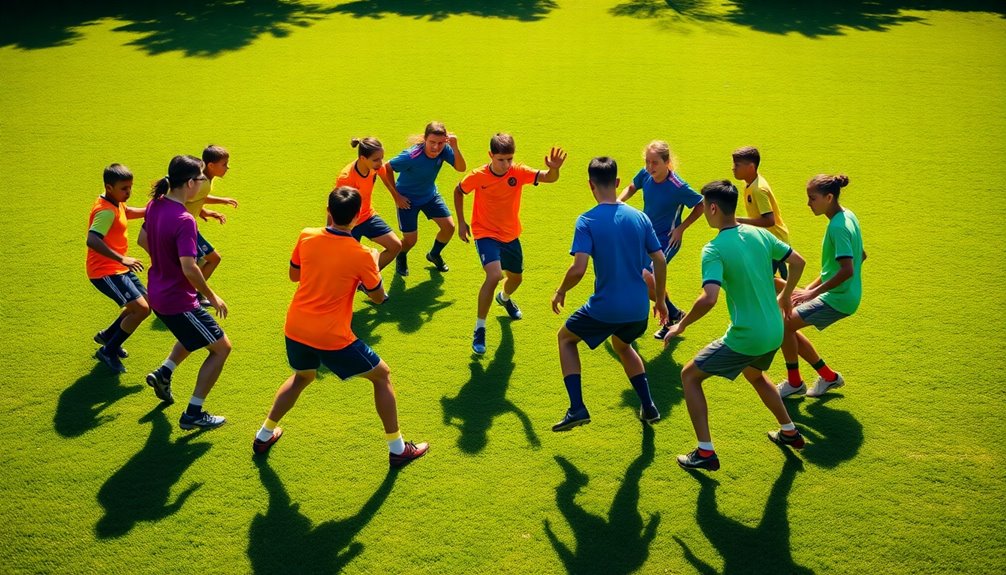
While many training methods exist, rondo drills stand out for their ability to enhance essential soccer skills in a dynamic environment. These drills sharpen your ball control and passing accuracy, vital for maintaining possession during matches. Additionally, consistent practice of rondo drills helps develop technical abilities that are crucial for overall performance. Engaging in these drills also contributes to improving agility and speed development, as players must constantly adjust their movements to maintain possession.
As you engage in rondos, you'll develop quick decision-making skills under pressure, improving your overall technical skills. Rondos also boost your awareness, encouraging you to scan the field for ideal passing options.
By fostering teamwork and communication, these drills create a competitive spirit that enhances social skills on the field. Plus, their adaptable nature allows players of all ages and skill levels to benefit, gradually increasing challenges as your abilities improve.
Ultimately, rondos build your confidence in maneuvering tight spaces and switching roles effectively. Additionally, incorporating advanced soccer tricks such as the Brazilian elastico can provide further opportunities for creativity and deception in your gameplay.
Understanding Rondo Variations
Rondo variations offer a versatile way to challenge players and enhance their skills on the field. By adjusting the number of players involved, you can create different dynamics that impact passing options and pressure:
- 3v1 – Maximizes pressure on the defenders, pushing attackers to find quick solutions. This scenario can also enhance speed endurance as players must react quickly under pressure. Additionally, it encourages players to develop close ball control under intense situations.
- 5v2 – Provides more passing options and encourages ball circulation among teammates.
- Moving rondos – Engage players in spatial awareness by shifting through adjacent grids.
- Additional rules – Incorporate a minimum number of passes or specific movements to heighten the competitive aspect.
These small-sided games not only sharpen tactical strategies but also force players to adapt while dealing with defensive players, keeping drills fresh and challenging. Additionally, implementing variations can help players master essential techniques that improve their overall gameplay.
Rondo Drills for Skill Development
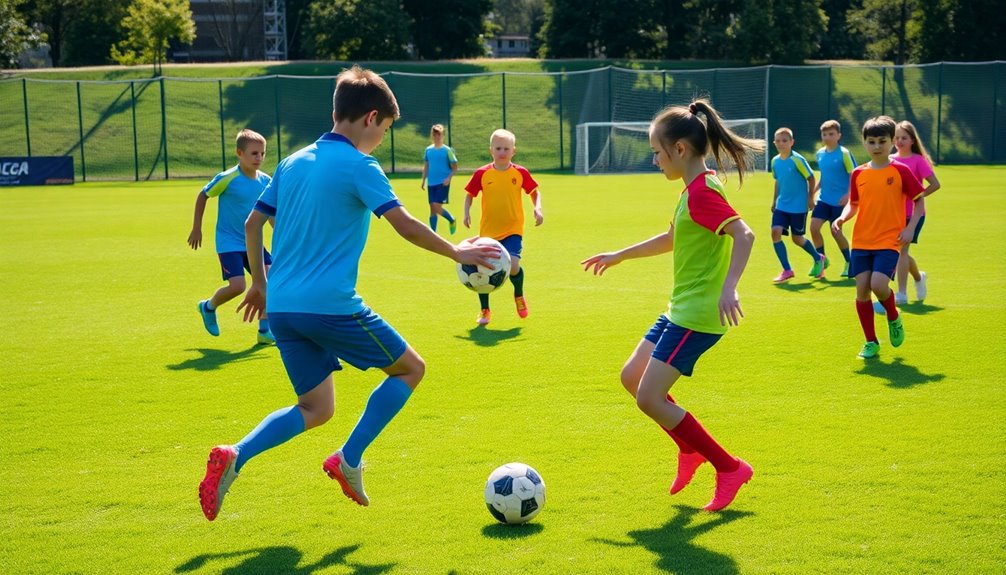
Building on the understanding of rondo variations, implementing specific drills can greatly enhance skill development for players at all levels. Rondo drills, such as 4v2 or 5v2, create pressure, sharpening both attackers' and defenders' skills.
Incorporating touch restrictions, like one-touch passes or using your weaker foot, greatly boosts passing accuracy and first touch under pressure. These drills emphasize quick decision-making and tight ball control, simulating match scenarios you'll face during games. Engaging in rondos also helps develop agility and speed through the fast-paced nature of the drills, enhancing overall performance on the field. Moreover, practicing these drills can lead to improved teamwork and communication, vital for success in matches.
Engaging in rondos not only improves possession but also enhances your vision and awareness of surrounding players. To keep training sessions dynamic, regularly change the grid size and the number of balls in play, catering to different skill levels while focusing on various aspects of possession. Additionally, incorporating dynamic stretches before rondo practice can help prevent injuries and improve overall flexibility.
Rondo Implementation in Training Sessions
Integrating rondos into your training sessions can greatly enhance player performance and engagement. These drills not only activate players mentally and physically but also set the stage for more intense practice.
Here are some key ways to implement rondos effectively:
- Warm-Up: Use rondo drills as a dynamic warm-up to prepare players for training games.
- Adjust Variables: Change grid size and player configurations to challenge players in keeping possession against defenders.
- Monitor Engagement: Keep an eye on player involvement, adapting practices to maintain interest.
- Game Situations: Confirm rondos reflect realistic scenarios to improve passing and receiving skills.
Tactical Insights From Rondos
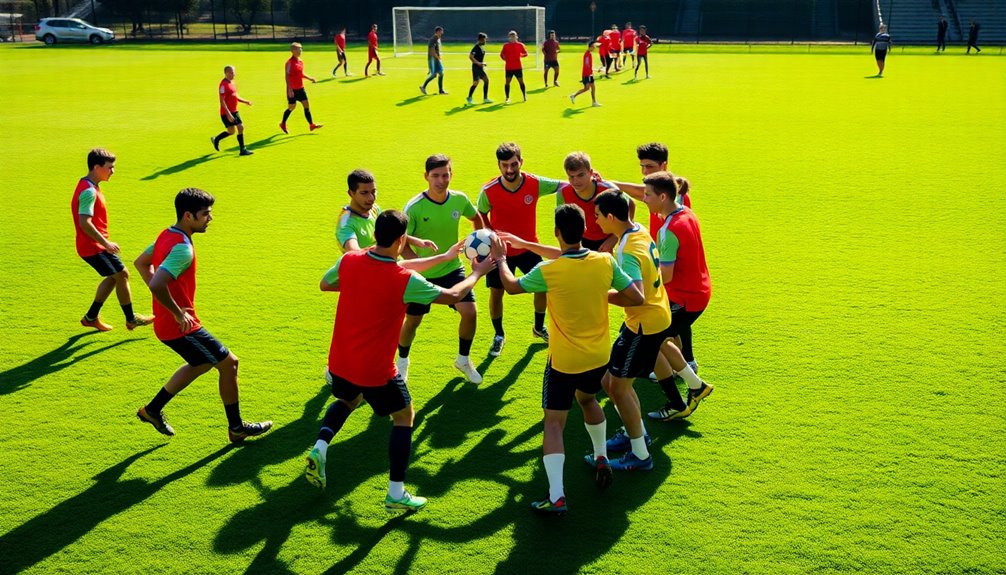
While practicing rondos, players not only sharpen their technical skills but also gain valuable tactical insights essential for game situations.
These drills simulate pressure, enhancing your tactical awareness and decision-making when maintaining possession of the ball. You learn to create space and support angles, concepts that translate directly to match play.
By varying touch restrictions and formations, you adapt your tactics, deepening your understanding of positional play.
Rondos also foster teamwork, as you coordinate movements and passing options with teammates to outmaneuver defenders.
Coaches effectively use rondos to introduce fundamental tactical principles like pressing and covering, vital for robust team defense and smooth shifts.
Embracing these insights can elevate your overall game performance.
Engaging Players With Creative Rondo Variations
To keep training sessions fresh and exciting, incorporating creative rondo variations can greatly enhance player engagement. Here are four engaging variations to contemplate:
- Escape The Rondo: Defenders dribble outside the grid after winning possession, promoting quick shifts.
- Rondo Pressure Drill: Teams compete to complete the most consecutive passes while under pressure, fostering teamwork and defensive skills.
- Rondo To Attack: Players must achieve a set number of passes before shifting to goal-scoring opportunities, blending possession practice with finishing skills.
- Dynamic Grid Adjustments: Altering grid size and player configurations keeps training competitive and tailored to different skill levels.
These creative rondo variations not only boost player engagement but also sharpen possession skills, making training sessions more effective and enjoyable.
The Role of Communication in Rondos
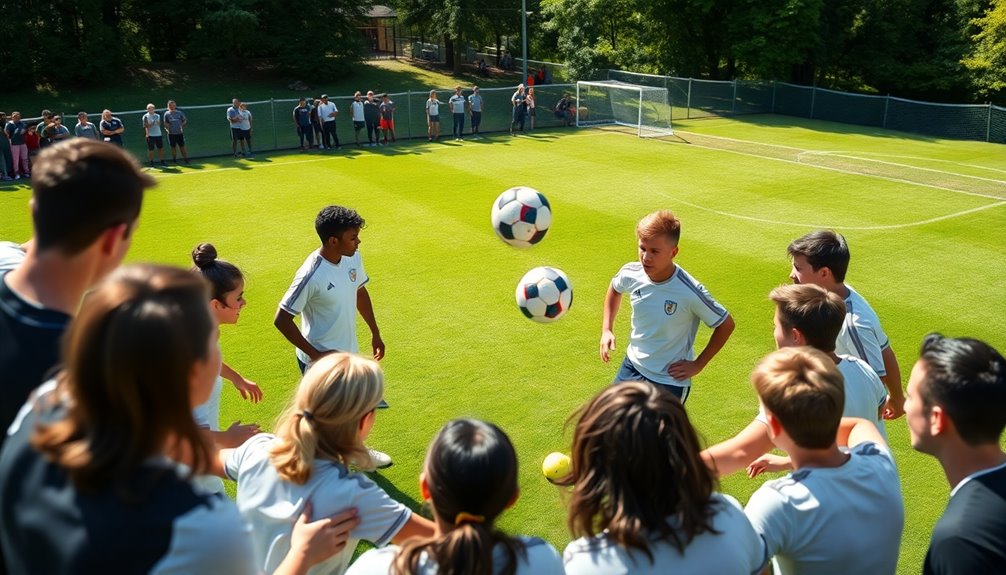
How can effective communication transform the way players interact during rondos? It enhances awareness of teammates and defenders, leading to quicker decision-making and improved passing.
You'll find that using verbal cues and body language helps signal your intentions, fostering a deeper understanding of positioning and movement in tight spaces.
The dynamic nature of rondos requires constant dialogue among players, which builds teamwork and a shared responsibility for maintaining possession.
Regularly practicing communication boosts your confidence to express yourself on the pitch, essential during high-pressure situations.
Coaches emphasize specific communication, like calling for the ball or indicating support angles, to optimize your interactions and elevate overall team performance.
Embrace these strategies, and watch how your rondo skills flourish!
Enhancing Team Dynamics Through Rondos
When you engage in rondos, you'll notice a boost in communication skills as players call out support and positioning.
This competitive environment not only fosters a stronger team spirit but also enhances cohesion, making everyone feel more connected.
As you practice together, you'll develop a better understanding of each other's roles, leading to seamless teamwork on the field.
Improved Communication Skills
While engaging in rondos, players not only sharpen their technical skills but also enhance their communication abilities, which are vital for effective teamwork.
Here's how rondos improve your communication skills:
- Verbal signals help you announce passing opportunities, ensuring smooth shifts.
- Non-verbal cues allow quick adjustments for positional changes, keeping the game fluid.
- Tight spaces boost your ability to relay information rapidly, critical for maintaining possession.
- Familiarity with teammates enhances chemistry, leading to better understanding of each other's playing styles.
Increased Competitive Spirit
Rondos not only sharpen your technical abilities but also ignite a competitive spirit among players, enhancing team dynamics.
In the competitive environment of rondo soccer, you'll endeavor to maintain possession, working closely with teammates to outmaneuver defenders. The structured drills foster communication, allowing you to coordinate movements and strategies effectively, especially in tight spaces.
Introducing elements like counting consecutive passes or setting time limits boosts engagement and motivation, driving everyone to improve collectively.
Additionally, the shift from offense to defense highlights the need for quick decision-making, essential in match situations.
As you engage in rondos, you'll also develop camaraderie, celebrating shared successes as a team while steering through challenges together.
Enhanced Team Cohesion
As players engage in rondos, they naturally enhance team cohesion through constant communication and collaboration.
This dynamic drill fosters an environment where you can:
- Celebrate successful ball retention with teammates, boosting camaraderie.
- Switch roles frequently, building empathy for each other's responsibilities.
- Improve quick decision-making skills as the game speeds up.
- Develop a deeper understanding of your teammates' playing styles.
Case Studies: Successful Coaches and Their Rondo Techniques
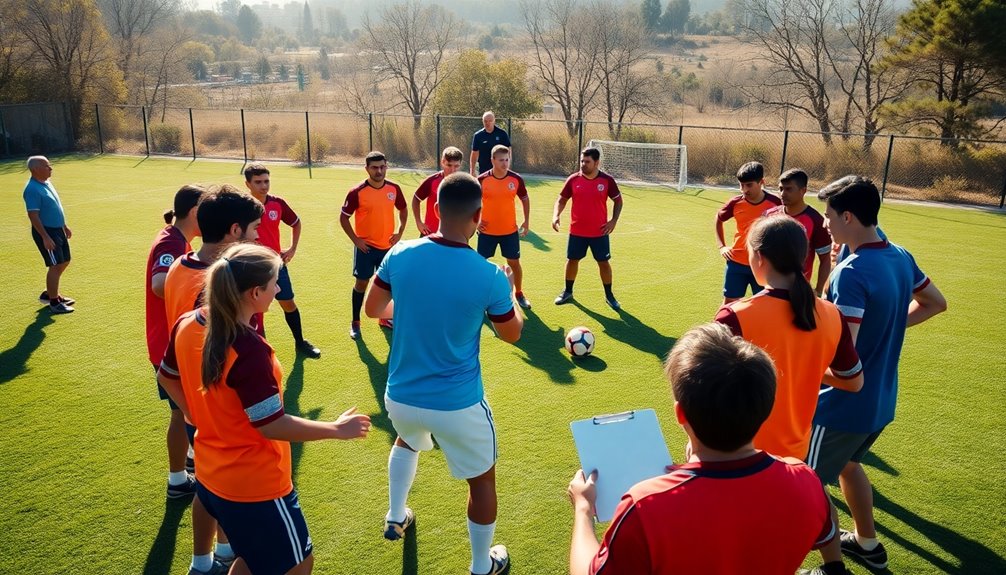
Successful coaches have recognized the immense value of rondos in developing players' skills and tactical understanding. Johan Cruyff popularized rondos at FC Barcelona, transforming them into essential training tools that enhance decision-making and technical abilities.
Similarly, Pep Guardiola incorporates rondos at clubs like Barcelona and Manchester City to promote quick passing and fluid movement, critical for his possession-based style. Coaches use various formats, like 4v1 or 5v2, to tailor training sessions according to players' skill levels, fostering teamwork and communication.
The integration of rondos in youth academies has led to improved passing accuracy and heightened awareness on the field, showcasing their effectiveness in nurturing young talent and preparing them for competitive play.
Conclusion
Incorporating rondos into your training can transform your team's dynamics and skill level. You'll notice how players not only enhance their technical abilities but also develop a deeper understanding of teamwork. Coincidentally, as they communicate and collaborate during these drills, you'll find that camaraderie grows, fostering a supportive atmosphere. So, immerse yourself in the world of rondos, and watch your players thrive both individually and collectively—it's a simple drill that can yield profound results on and off the field.


